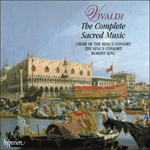On two separate occasions, Vivaldi returned to his A major setting of the Laudate pueri (RV602), adapting and updating it for new purposes. RV602a is the earlier adaptation, probably dating from the late 1720s. Since he no longer cultivated the faux-naïf style of the previous decade, Vivaldi replaced the sixth movement (‘Ut collocet eum’), by a rather conventional aria in G major for second (in place of first) soprano and strings. He restored equality between the soloists by reassigning the seventh movement (‘Gloria Patri’) to the first soprano, at the same time replacing the oboe by the newly fashionable flute. The two versions are not very different, but the obbligato part is tailored very sensitively to the new instrument, which results in a number of interesting changes. This second version makes a delightful stocking-filler.
from notes by Michael Talbot © 2003
A deux reprises, Vivaldi revint à sa réalisation en la majeur du Laudate pueri (RV602) pour répondre à de nouveaux besoins en l’adaptant et la remaniant. Datant probablement de la fin des années 1720, RV602a est la version adaptée la plus ancienne des deux. Puisqu’il ne cultivait plus le style faux-naïf de la décennie précédente, Vivaldi remplaça le sixième mouvement (« Ut collocet eum ») par une aria plutôt conventionnelle en sol majeur pour second soprano (en place du premier) et cordes. Il restaura l’égalité entre les solistes en redonnant au premier soprano le septième mouvement (« Gloria Patri »), remplaçant au passage le hautbois par la flûte qui était alors le nouvel instrument à la mode. Les deux versions ne sont pas très différentes, mais la partie obbligato répond avec sensibilité aux nécessités d’écriture du nouvel instrument, ce qui conduit à un certain nombre de changements très intéressants. Cette seconde version est un délicieux petit bijou.
extrait des notes rédigées par Michael Talbot © 2003
Français: Isabelle Battioni
Zu zwei verschiedenen Gelegenheiten kam Vivaldi auf seine A-Dur Vertonung des Laudate pueri (RV 602) zurück, um sie etwas umzuändern und wiederzuverwenden. RV 602a ist die frühere Bearbeitung und stammt wahrscheinlich aus den 1720er Jahren. Da er sich nicht mehr, wie in der Dekade zuvor, des faux-naïf-Stils bediente, ersetzte er den sechsten Satz („Ut collocet eum“) durch eine recht konventionelle Arie in G-Dur für den zweiten Sopran (anstelle des ersten) und Streicher. Im siebten Satz („Gloria Patri“) stellte er den Ausgleich zwischen den Solistinnen wieder her, indem er ihn nun der ersten Sopranistin zugedachte. Gleichzeitig ersetzte er die Oboe mit der neuen, modernen Flöte. Die beiden Versionen unterscheiden sich nicht sehr voneinander, jedoch ist die obligate Stimme dem neuen Instrument auf sehr feinfühlige Art zugeschnitten, was für mehrere interessante Veränderungen sorgt. Diese zweite Fassung ist eine reizende kleine Beigabe.
aus dem Begleittext von Michael Talbot © 2003
Deutsch: Viola Scheffel


 Vivaldi: The Complete Sacred Music
Vivaldi: The Complete Sacred Music
